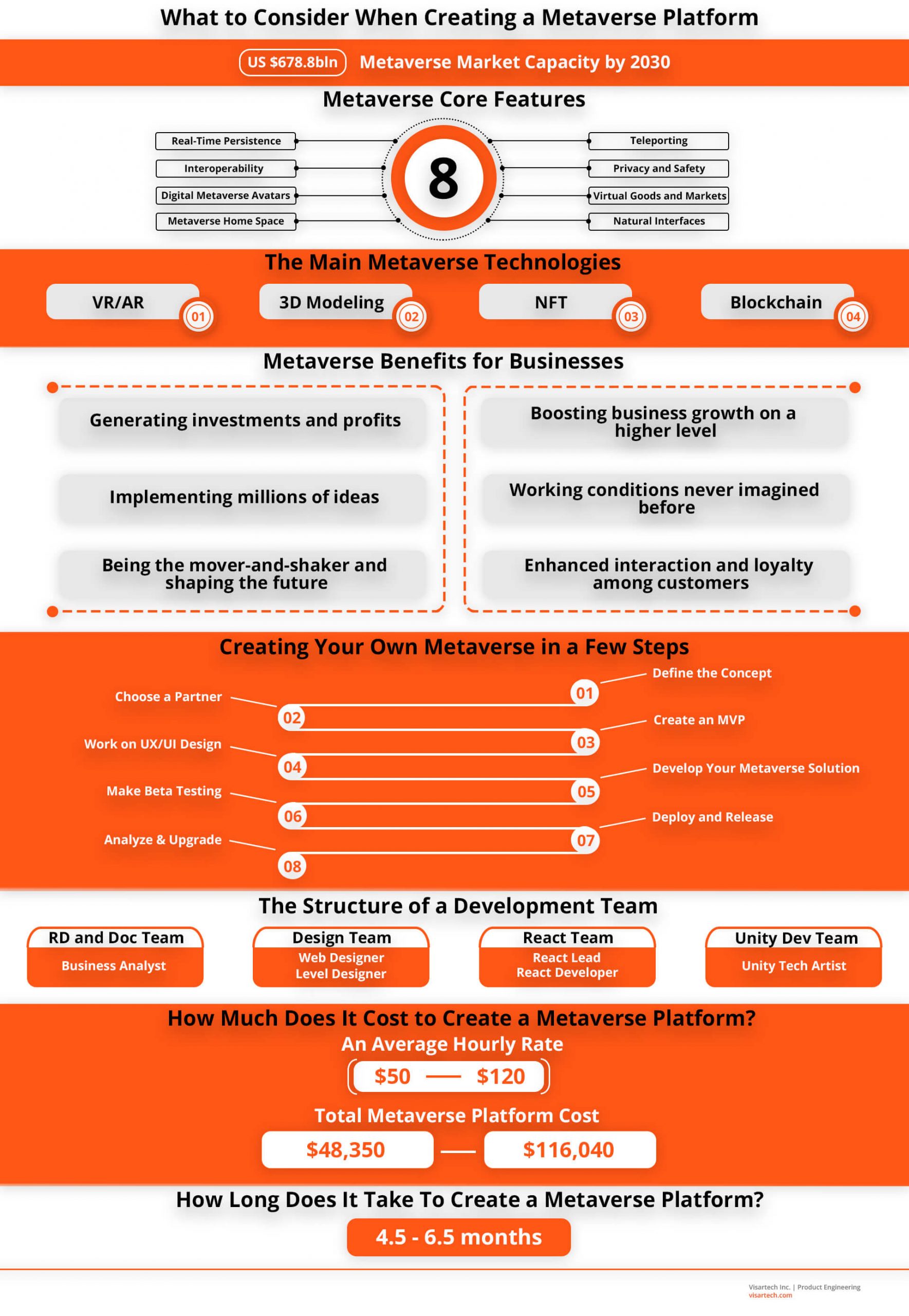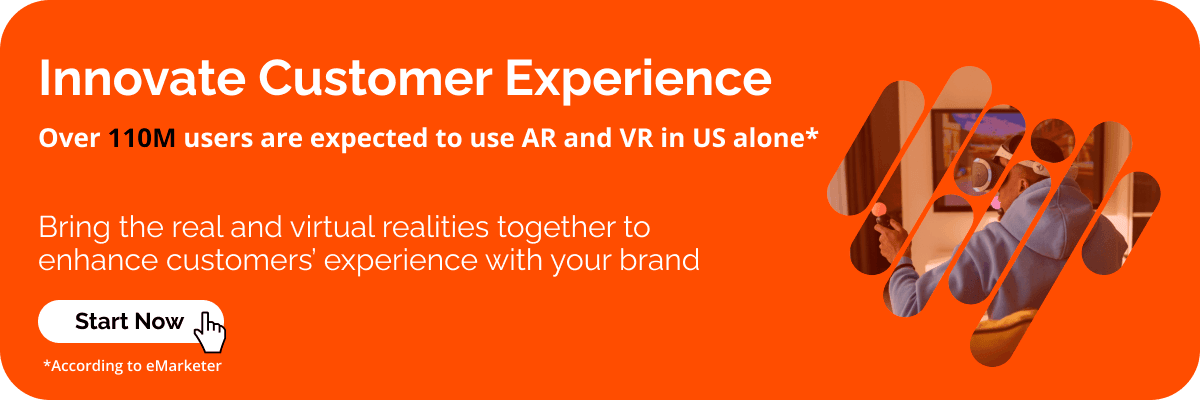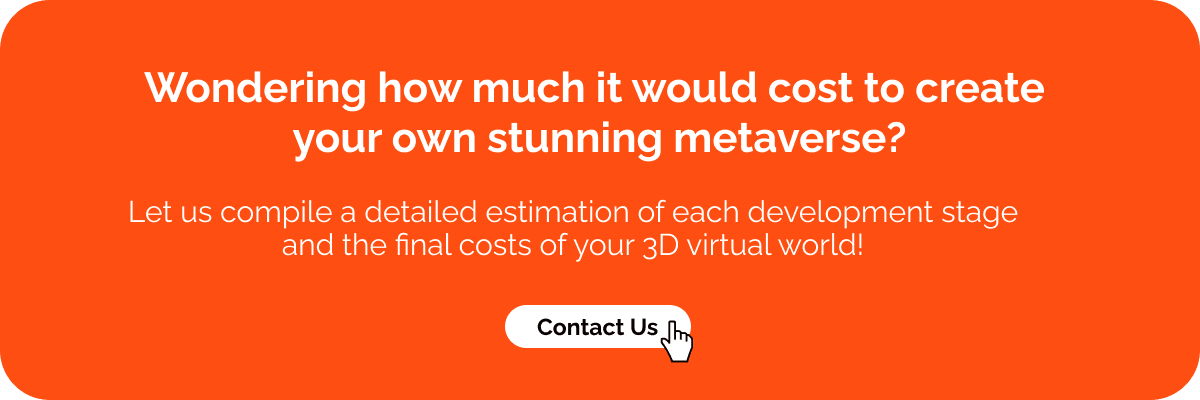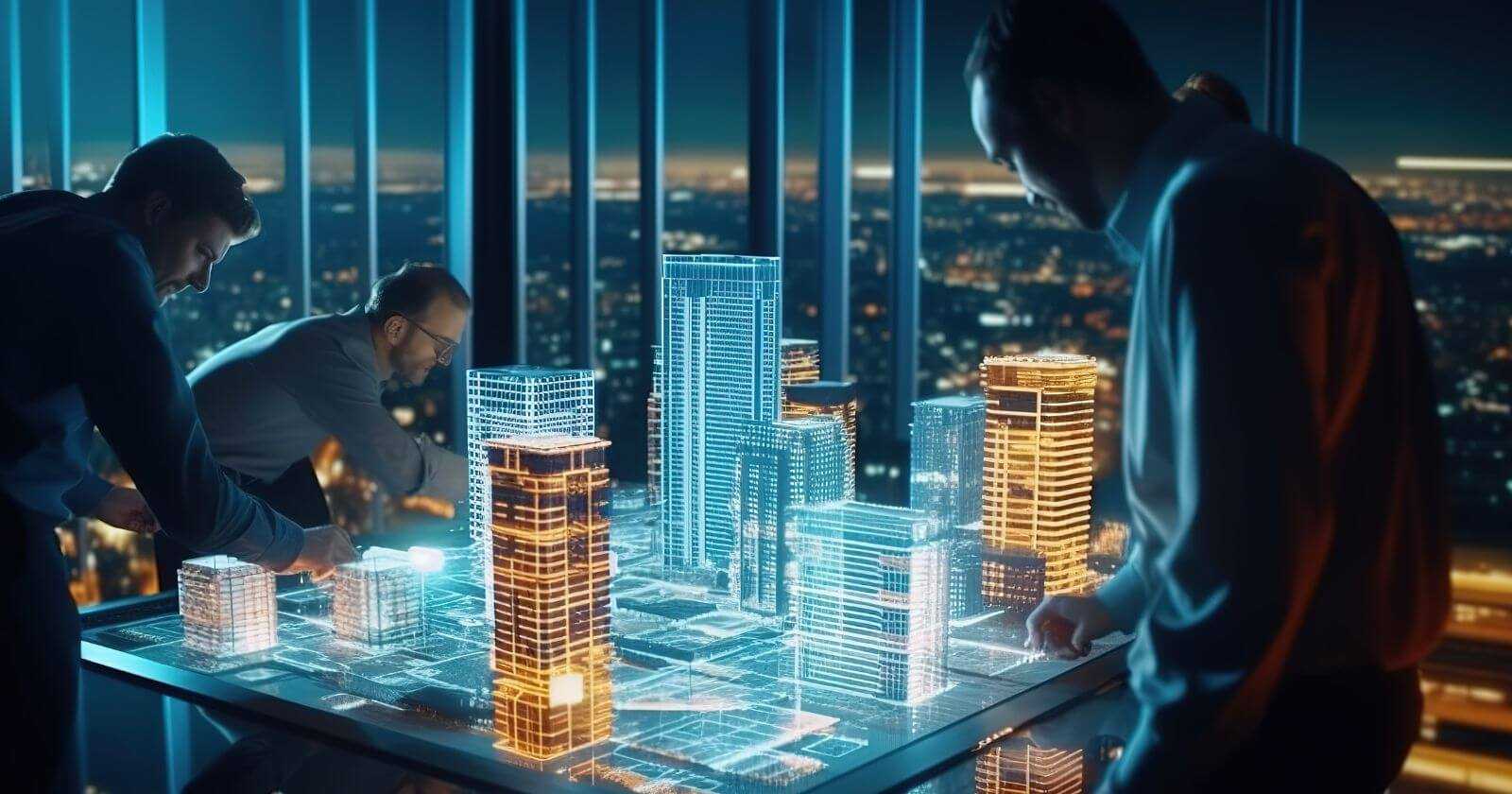Virtual reality has come a long way from being a mere futuristic concept to a transformative technology that is now reshaping the digital landscape. The Metaverse, a term that once belonged to science fiction, now is considered as an in-demand software solution that grabs clientele attention and transforms internal business operations. It comes as no surprise because the metaverse applications bring benefits for all organizations – large-scale companies, startups and so on.
One more benefit is its accessibility, as any metaverse is designed to be inclusive. Virtual space optimizes budget allocation by fostering virtual collaboration, enhancing global reach, and creating immersive customer experiences.
Sounds perfect, doesn’t it? However, there’s more to it. In this guide, you’ll discover the potential benefits that metaverse can bring in your company, accompanied by practical use cases to illustrate its implementation.
What is Metaverse, Exactly?
Metaverse is a virtual, shared, and interconnected digital universe where users can interact with each other and environments in real time through their 3D avatars.
The term “metaverse” was coined by writer Neal Stephenson back in 1992. He described it as a digital world where people connect with the surroundings like they would in real life.
If this reminds you of the Internet, you’re right. The Metaverse also links people and businesses through technologies, but it does so at a higher level. Here’s how Meta illustrates the idea of the metaverse:
“Like the internet, the metaverse will help you connect with people when you aren’t physically in the same place and get us even closer to that feeling of being together in person.”
Such innovations impact not only our social life but also the way we do business. There are several factors that defined the metaverse as a new opportunity for companies to set up reliable relationships with their clients or address internal business challenges:
- Technological Advancements. It’s predicted that the XR market will reach over 100 billion U.S. dollars by 2026.
- Desire for Immersive Experiences. In the United States, 36% of adults express interest in the metaverse, signaling a widespread demand for immersive online encounters.
- Shifting Work Dynamics. With 87% of employees favoring remote work, the metaverse offers an avenue for enhanced collaboration and communication.
- Effective Training and Skill Development. According to the PWC report, virtual reality training makes learners feel up to 275% more confident when using the acquired skills in real work scenarios.

So what are technologies that metaverse development companies leverage to create such a powerful solution for businesses? Let’s reveal it in the next section.
4 Technologies Powering The Metaverse
To understand how to develop a custom virtual world, let’s examine the four key tech solutions that are here to power metaverse:
#1. VR/AR Development
Software engineers use VR technology to create a sense of being present within the metaverse. This involves crafting 3D models and simulations that replicate our physical world. The best metaverse apps are also focusing on non-visual effects for enriched user experience through integration with VR devices, body sensors, and creating sound design.
AR development merges the material world and virtual elements. Within the scope of metaverse app development, its goal is to create tools that facilitate user interaction with the digital realm via cameras and device screens. Through the incorporation of images, text, and sounds, AR solutions transform user perception of surroundings, fostering increased immersion.
Tech stack: Google VR, Apple ARKit, Google ARCore, Vuforia, 8th Wall.
Read more: Interactive 2D/3D Graphics for Web Projects
Discover WebGL capabilities your business can benefit from
#2. 3D Development
When it comes to creating metaverse elements like buildings, plants, or avatars, it’s impossible to skip 3D development. 3D models serve as the digital building blocks that bring the metaverse to life, offering a visual representation of the virtual environment and its users.
It’s also worth mentioning that 3D copies aren’t static and can include many interactive features. Imagine exploring a virtual museum where you can approach a 3D sculpture, rotate it with a swipe, or open the door and step into another exhibit room. All this is possible thanks to the tools included in 3D engineering services.
Tech stack: Unity, PlayCanvas, Babylon.js, three.js.
#3. NFT
Bet you’ve heard of an NFT – a token that proves ownership of a digital object. The metaverse provides an ideal landscape for NFT development, offering a decentralized and secure environment for the creation, buying, selling, and trading of these digital assets. NFTs enable artists and creators not only to monetize their work but also empower users to customize their virtual personas and surroundings with unique items that hold real value.
#4. Blockchain
In the metaverse, blockchain technology provides security and transparency of transactions, exchanges, and interactions between people. It allows you to create unique digital assets which are the users’ properties. Such an approach provides an easier way to verify ownership, as there’s no need for intermediaries such as banks or payment systems.
Now that you know which technologies to use for effective metaverse development, let’s find out the main features each metaverse solution should include.
The Metaverse and Its Core Features
Whether you’re creating a digital classroom for school, industrial 3D space for remote control and collaboration, or virtual stores to sell products in the metaverse, this requires incorporating some key features to succeed. These are:
- Unlimited Space
Picture a universe that keeps getting bigger. This is the idea of the Metaverse. To implement it, you need high-speed interactions and unprecedented scalability. All this is possible when building a resilient IT Infrastructure.
- Real-Time Persistence
Persistence means that everything within the metaverse, including objects, actions, and modifications, remains after users log out from the virtual space. This opens up possibilities for establishing enduring projects, communities, economic structures, and other interactions in the metaverse. This way, users can build, interact, and engage with greater lasting impact.
- Digital Metaverse Avatars
You can create a virtual representation of the user based on his real photo or make a completely fictional avatar. In both cases, it’s a way to express your identity through digital means. Metaverse avatars facilitate lifelike interaction with the environment and participants, mirroring real-world communication.
- Natural Interfaces
The metaverse app with a natural interface includes features that allow you to engage with an environment using modalities such as touch, gesture, or voice. These interfaces aim to create a seamless and immersive user experience by mimicking interactions from the physical world.
- Teleporting
In the Metaverse, teleporting isn’t constrained by physical limitations like time or distance. Users can effortlessly shift from one virtual location to another in an instant, removing the need for lengthy journeys or loading screens.
- Virtual Land
By purchasing a virtual land, you can build a unique space and present your brand, products, and services in an interactive format. Namely, it can be creating a virtual shop, conference, or workshop. Furthermore, investing in digital property offers the opportunity to gain significant value in times to come.
- Virtual Goods and Markets
Remember when we said that people can act in the metaverse exactly like they do in real life? This applies to purchases as well. It’s similar to how we buy goods online via a website but better. In the metaverse, the user browses the products in the virtual shop and even can try them on.
- Privacy and Safety
Considering that users share data inside the virtual realm, the importance of cybersecurity measures when developing a metaverse can’t be undervalued. Beyond controlling user access and conducting regular system testing, the metaverse also incorporates security through ethical standards and privacy protocols within its ecosystem.
It’s important to note that your metaverse application development process may include creation of other features that will increase the user experience for your specific audience. With the appropriate metaverse tech stack, we can open broader possibilities in the virtual world.
Web3 vs Metaverse: How Are They Different?
In one of our articles, we have already detailed the concept of Web 3, along with the reasons and methods for businesses to embark on the Web3 solutions development. In brief, it entails a decentralized internet which gives us better control over our data.
Read more: How the Emerging Web 3.0 Transforms the Existing Business Models
Learn all about Web 3.0 and how it can benefit your brand
Both solutions have several factors in common. For example, the metaverse functions without a centralized hub. And so does Web3. The use of blockchain allows them to craft a distributed internet, where communication takes place through a system of computers instead of centralized servers.
Similarly, in both tech concepts, people can buy and sell digital assets. You can keep these properties in a peer-to-peer virtual wallet. This means unmitigated users’ autonomy.
With so much in common, what sets metaverse and Web 3.0 apart? Consider the following three factors explaining this:
- Purpose
The concept of the metaverse aims to provide individuals and businesses a new more immersive than other apps ecosystem for commercial and non-commercial purposes. Web3’s primary objective is to grant users greater control over their data and reduce dependence on central authorities.
- Core Elements
Typically, 3D environments, user-generated content, digital economies, and lifelike social engagements. Web 3.0, in turn, encompasses decentralization, employs blockchain technology, utilizes smart contracts, and integrates cryptographic principles.
- Implementation
Initially seen as primarily applicable in gaming or digital commerce, the metaverse now shows its potential in addressing complex business challenges (e.g. in manufacturing, government sectors). Concerning Web3, it can be utilized in different industries yet it’s particularly popular in finance and blockchain finance, gaming, and social networks industries.
Although Web3 and the developed 3D digital world share the core concepts of decentralization and user possession rights for virtual assets, they can’t replace each other. Each has its unique strengths and applications aiming to solve different challenges businesses may face.
Key Metaverse Benefits For Businesses
Most business sectors have already invested in metaverse development. Meanwhile, others have created the first metaverse solutions in their industries. Such a fast-moving pace of the metaverse market can exceed all expectations and rise to $ 678.8 billion by 2030.
Overall, we can define the following metaverse advantages that drive businesses to make investments in virtual worlds development:
Better Shopping Experiences
It’s about building a stronger bond with the customers who explore and make purchases within the digital realm. Beyond just a physical showroom, you can provide customers with the option to explore products in a crafted metaverse that replicates your store. Enhance the shopping experience by incorporating an AI assistant within your virtual store. This ensures a two-way interaction with buyers and allows you to collect feedback.
Improved Working Сonditions
You can incorporate metaverse for streamlining remote work by crafting digital offices. The potential economic benefit here is decreasing expenses associated with physical office spaces.
But beyond that, metaverse also introduces a way to optimize “informal” communication between remote employees. And that’s really important. For example, casual chats among colleagues during lunch breaks or around the coffee machines in Google fostered innovations such as Google Art Project and successful AdWords features (Automated Rules). Given that the metaverse provides more immersive communication methods compared to traditional video conferencing, this will enhance employee communication for both formal and informal discussions.
Enhanced Interaction With Customers
This is probably the most evident yet very important advantage the digital universe offers to enterprises. For companies seeking to enhance their customer interactions, metaverse with virtual showrooms and personalized avatars is a great option.
Reaching a Global Market
With the digital world transcending geographical boundaries, enterprises can tap into diverse markets and engage with audiences worldwide. This accessibility empowers businesses to liberate themselves from the limitations imposed by tangible premises.
New Avenues for Investment and Profitable Ventures
Since many people are showing interest in the 3D virtual realm these days, investing in this field is becoming increasingly profitable. Companies can strategically allocate resources to virtual real estate, digital assets, and new technologies, anticipating capital growth.
With people becoming more familiar with the metaverse, businesses can expect increased interest in more engaging experiences among their customers. However, metaverse development offers extensive benefits for businesses by optimizing not only external but also internal processes. Keeping this in mind, we can expect the idea of virtual worlds to become increasingly common in the business world.
5 Vivid Metaverse Use Cases
In a nutshell, there are two ways to get economic advantage from building a custom metaverse for organizations. The first is to choose a business model based on selling products and services in the virtual world. The second is creating a custom software solution that aims to solve specific internal challenges and optimize the company’s costs. In this section, we consider five metaverse use cases that cover both potential options.
Metaverse Solutions for Industrial Excellence
Unlike simulation, the industrial metaverse operates continuously. It means that the functioning of manufacturing machinery, buildings, grids & transportation systems or even the whole factories are copied in a 3D simulated environment.
For heavy industries (oil & gas, mining, or construction) the idea of repeated industrial operations is important since it’s challenging to control all parameters of equipment or complex products. Instead, workers at plants can monitor it through a custom metaverse ecosystem – adjust the necessary indicators for tracking production lines and identify bottlenecks in production. One key point to highlight is that all these (and more) processes can be done remotely.
It’s crucial to mention that in the scenario of the industrial metaverse, the required technologies we mentioned above may not be sufficient. Usually, enterprises combine virtual space development with IoT technologies. The data collected by IoT sensors is delivered into the metaverse for instant display and remote monitoring of industrial operations.
Enterprise Metaverse (Remote Collaboration/L&D)
The metaverse’s significant value in remote collaboration lies in its capacity to replicate in-person interactions. Employees can connect in virtual break rooms or discuss ideas in a shared virtual environment. Unlike video calls, it will bring a sense of presence among colleagues.
At the same time, the metaverse in the corporate realm is also used to optimize educational programs. For example, HR directors who mark quick onboarding of new employees as a challenge recognize metaverse as a solution. A developed bespoke digital environment allows new hires to navigate through virtual office spaces, meet team members in a simulated environment, and access the company’s resources faster than traditional onboarding.
Another challenge metaverse addresses in learning and development projects is the lack of engagement and struggle to accommodate diverse learning styles. In the metaverse, employees can acquire new skills and knowledge more memorably, enhancing the effectiveness of skills development programs.
Metaverse for Schools & Higher Education
The research by Statista found that education was the second largest business sector investing in developing the metaverse in 2022. Virtual classrooms transcend geographical boundaries, enabling students to participate in interactive lessons from anywhere.
A bright illustration of the educational virtual shared space is Immerse. This is a platform for people to learn and practice new languages, sidestepping the challenges of navigating borders, grappling with daunting textbooks, or resorting to inconsequential app downloads.
Online Tourism
We don’t think that metaverse tourism will replace traditional travel experiences. Although virtual travel is a popular metaverse application, there are more ways for tourism agencies to incorporate developed 3D virtual space into their operations.
Consider, for instance, personalized consultations within the metaverse. Picture a scenario where a travel consultant assists customers in selecting a vacation destination within a virtual environment that accurately replicates all the attractions of the resort. This approach proves to be an excellent way to captivate travelers and motivate them to explore more.
One excellent example of a metaverse in the tourism domain is Ariva Wonderland. It’s an online platform that provides visitors with immersive, virtual replicas of well-known physical landmarks. Explorers can experience digital versions of famous sites (e.g. Eiffel Tower, Statue of Liberty, Arc de Triomphe).
Real Estate
Online property tours and 3D apartment design enable potential buyers and tenants to view homes and commercial spaces without leaving their homes. Apart from saving time spent on physical examination of the building, this also enhances accessibility for individuals with mobility constraints or those located at a considerable distance from the property.
Moreover, the construction companies can utilize the 3D environment when working on building’s architectural structure and design. This allows stakeholders to collaborate remotely and discuss plans or make decisions within a unified virtual system.
Read more: All About VR in Virtual Design and Construction
Explore how VR development can improve you VDC platform
The ways to implement a metaverse software solution in business processes are limitless and the listed five applications are only some of them. Start thinking about your objectives and needs to craft the right simulated space that your team and clientele will love. Then, leverage your metaverse solution to start building stronger relationships with clients, elevate the customer journey, and save your team time.
How to Create a Metaverse in 8 Steps
There are few metaverse platforms to create metaverse rooms or spaces for interaction. Namely, Roblox, Decentraland, The Sandbox, etc. They serve to help us participate in virtual communities, metaverse events, or games.
However, we are not able to get more of that and create something of our own. For instance, virtual e-learning marketplaces, networking platforms, shops, galleries, etc. This requires custom metaverse development which consists of the following steps:
#1. Define the Concept
The first stage involves conceptualizing the 3D space, determining its purpose, and establishing the key elements. It’s imperative to conduct extensive market analysis to identify gaps and prospects, ensuring the concept aligns with emerging trends. Consider integration of any other technologies that could upgrade your future metaverse ecosystem – for example, AI features to automate communication with users or include AI-powered data analytics capabilities.
#2. Choose a Software Development Partner
Opt for professionals who possess expertise in 3D engineering, VR/AR development, blockchain, and multiplayer game development. Their prowess in metaverse tech stack such as Unity or Unreal Engine is vital to develop eye-catching 3D metaverse spaces. Collaborate with a partner experienced in developing scalable and secure systems, as the metaverse demands robust infrastructure to support seamless user interactions.
#3. Create a Basic Prototype
Focus on fundamental functionalities that capture the core of the metaverse. Implement basic asset creation, user avatars, and rudimentary interaction mechanics. This serves as a testing ground for initial user feedback, enabling agile refinement before progressing to more intricate features. Developing the basic metaverse prototype also aids in validating the feasibility of integrating blockchain for asset ownership and transactions.
#4. Work on UX / UI Design
Follow best practices such as implementing intuitive navigation, creating lifelike avatars, and adding spatial audio designs. Strive for a seamless transition amidst the digital and tangible components, emphasizing a user-centric design approach. Employ UI elements while ensuring accessibility across diverse platforms, from VR headsets to traditional desktop interfaces.
#5. Develop Your Metaverse Solution
Enter this stage armed with a comprehensive blueprint. Leverage programming languages like React and JavaScript for the frontend, while deploying smart contracts on blockchain networks like Ethereum or Binance Smart Chain for decentralized functionalities. Employing distributed ledger technology ensures secure virtual assets’ ownership and traceability. Implement scalable server architecture to accommodate a burgeoning user base and maintain real-time synchronization for a seamless, shared virtual experience.
#6. Make Beta Testing
This allows metaverse development companies to identify potential bugs, gauge server scalability, and gather invaluable user feedback. Leverage analytics tools to scrutinize user behavior within the metaverse. Addressing issues discovered during beta testing is crucial for refining the user experience, optimizing performance, and fortifying security measures. This phase is a pivotal checkpoint before proceeding to the next stages, warranting a meticulous evaluation of user input.
#7. Deploy and Release
Employ cloud services for scalable hosting and employ content delivery networks (CDNs) to ensure low-latency access globally. Implement robust security measures, including encryption protocols, to safeguard user data and assets. The release is a pivotal moment, necessitating effective marketing strategies to attract the target audience and drive user engagement.
#8. Analyze & Upgrade
To make sure your metaverse functions as planned, leverage user data and analytics to identify patterns and preferences, steering the metaverse’s development trajectory. Implement regular updates, introduce new features, optimize performance, and address emerging technological trends. Engage with the user community through forums, social media, and feedback channels, fostering a dynamic relationship that shapes the metaverse’s ongoing refinement.
This is the approximate path you will have to overcome when creating a custom 3D space application. It would seem that there are a lot of challenges and tech nuances to consider but partnering with a trusted metaverse development company that possesses the needed expertise will ensure all stages are done correctly and bring your company the best result possible.
How Much Does It Cost to Create Your Metaverse?
As virtual metaverse platforms have skyrocketed lately, the question regarding their development cost is arising. The metaverse price entirely depends on several aspects, including your business goals.
To determine the cost of your virtual world project, consider the following factors that influence metaverse development costs:
- the development team structure and their development skills;
- chosen tech stack for creating a metaverse world;
- the type of selected platform (mobile or web);
- the geographic location of the development team.
Any app development cost is influenced by hours for the particular platform development multiplied by the hourly rate of their specialists.
To find out the metaverse cost, let’s consider the main development stages and features of 3D environment platforms in detail.
The development of a metaverse basic prototype involves the following:
| Tasks/Features | Optimistic, Hours | Pessimistic, Hours | Time, hours |
| Registration/Login | 80 | 112 | 96 |
| Avatars | 154 | 332 | 243 |
| Environments | 272 | 328 | 300 |
| Communication | 150 | 216 | 183 |
| Sound design | 42 | 56 | 49 |
| Total | 698 | 1044 | 967 |
Consequently, the development of metaverse with basic features might take from 698 to 1044 hours. If you take the average rate of $50-120 per hour, the development cost of such a metaverse platform will be from $48,350 to $116,040.
The virtual world can be complemented by other metaverse features such as a presentation board, admin analytics panel, and event management. That also affects the final metaverse development cost.
What is the structure of an app development team that can create a metaverse platform?
Optimally, the engineering staff that assists in developing the metaverse is led by the Project Manager. To get the virtual world platform as close to flawless as possible QA Engineers are to test the metaverse solution. They check its performance, security, and usability. The remaining team members are grouped under several development teams.
RD and Doc Team:
- Business Analyst
Design Team:
- Web Designer
- Level Designer
React Team:
- React Lead
- React Developer
Unity Dev Team:
- Unity Tech Artist
Every virtual world-building project is unique therefore the number of key roles required might be different. Still, this estimation provides a general understanding of metaverse development cost along with the app development team needed.
How We Developed a Metaverse for Immersive Education
Drawing on over 13 years of experience in metaverse development services, Visartech has assisted enterprises in creating their own virtual worlds for business purposes. One key project our dedicated development team has been working on is the eLearning metaverse solution.
At the core of this web-based platform lies the interactive software solution aimed at enhancing learning processes at schools. It runs on PCs, Macs, and Chromebooks.
With the purpose of involving students in educational processes, our Visartech team created immersive study environments with built-in browser boards and 3D Art assets. Namely, the core features of this educational software solution are:
- life-like socialization;
- optimized teacher workload;
- integrated web browser;
- prevention of reverse engineering and hacks.
The educational platform has been recognized by top teachers in the US for its effectiveness in enhancing student engagement and collaboration. Moreover, it was featured at SXSW EDU, which showcases its commitment to innovation in education.
Final Words
Metaverse applications are often seen as fail-safe strategies for businesses to enter new markets and reach wider audiences for businesses. And it is, but most platforms for its development have a number of limitations, including the lack of customization and scalability. Still, you can take your metaverse to the next level by partnering with a metaverse development company that will build unique, flexible, and secure virtual space for your business.
Wanna find out the details on how to make smart moves into a metaverse market, contact us now!






